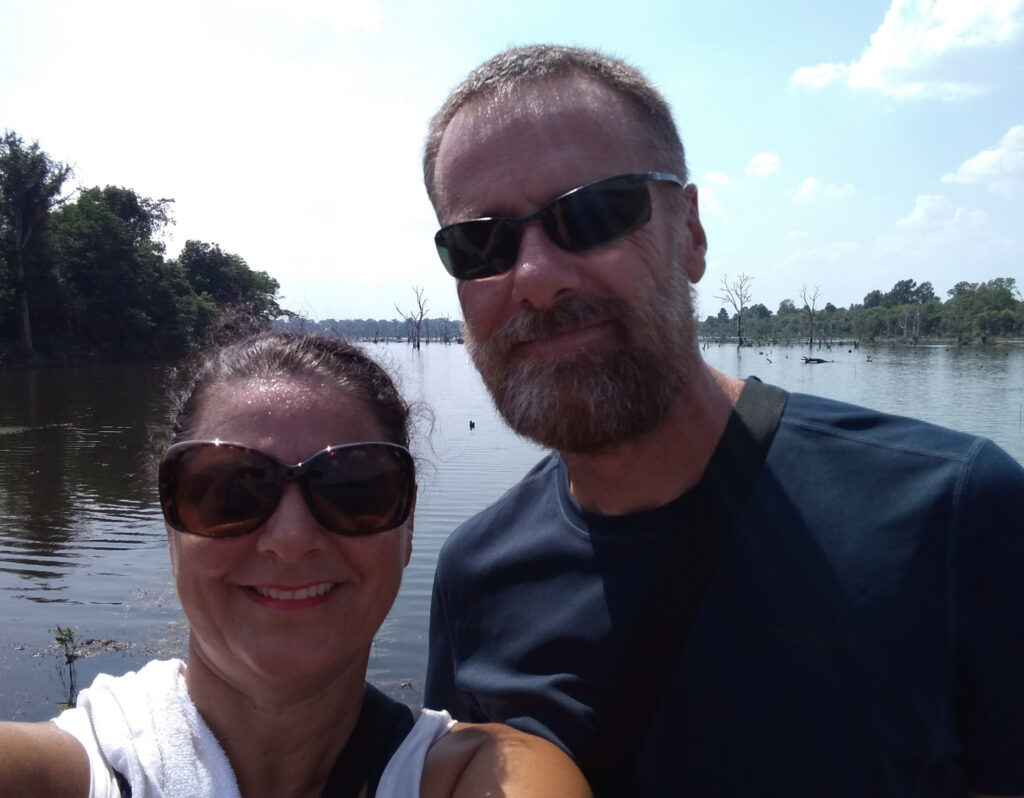“The gateway to the ruins of Angkor”.

see photos
Where is Angkor Archeological Park?
Angkor is located about 6 km to the north of Siem reap, about 20 minutes by car. There are dozens of ruins around Siem Reap. The most significant ones being in the Angkor Archaeological Park. Others are further afield.
The park is one of the most important archaeological sites in South-East Asia. Including forested areas, it contains the magnificent remains of the different capitals of the Khmer Empire, from the 9th to the 15th century.
They include the famous Temple of Angkor Wat and, at Angkor Thom, the Bayon Temple. Impressive monuments, ancient urban areas, and large water reservoirs, the site is a concentration of features testifying to an exceptional civilization.

Getting there
Most visitors stay in Siem Reap when visiting Angkor Archeological Park. We were no different. Our first journey from Battambang to Siem Reap was by minivan. Our second journey from Sihanoukville to Siem Reap was by a sleeper bus.
Our accommodation
Having had an extended stay in Cambodia owing to the COVID-19 pandemic, we visited Siem Reap twice. During our first tourist visit to Siem Reap we chose to stay at the Grand Elysee La Residence, booked through Booking.com. Our second visit was on more of a long term basis. During this visit, we chose to stay at Angkor Dino Residence, booked directly.
Grand Elysee La Residence
Situated about 800m from the town centre. The hotel has an outdoor swimming pool and a spa centre.
Our room was huge and came with a flat-screen TV, a seating area, a fridge, a wardrobe, tea/coffee making facilities, air conditioning, and a balcony with chairs. The private ensuite bathroom came with bathrobes, slippers, and free toiletries.
The poolside restaurant offered good food. Breakfast was extremely good.
Angkor Dino Residence
Located about halfway between the centre of Siem Reap and Angkor Wat temple. 1 km from one of the biggest supermarkets in Siem Reap and 500m from the local market of Psa Kralagn.
Our apartment was tastefully decorated and came fully equipped with a king sized bed. Along with air conditioning, a TV, a wardrobe, a dining table and chairs, and a kitchenette complete with utensils.
A modern single ring gas stove was provided, supplied from a large gas bottle outside of the apartment. The private bathroom came with a hot water shower and the toilet had an extractor fan. Included in the monthly rental is cleaning once a week and a change of bed linen and towels weekly.
What to take when visiting the park
No matter what time of year you visit the park, it will be hot. Either just plain hot, hot, and humid or hot and sunny. Just damn hot. With this in mind, dress appropriately for the heat and respectfully for visiting the temples.

Revealing clothes such as shorts and skirts above the knees and showing bare shoulders are prohibited. Being a sacred site, pay due respect to the temples by being considerate of worshipers and monks, not climbing up the temples and taking litter home with you.
Sensible footwear is essential as there is a great deal of uneven ground and plenty of steps. There are plenty of vendors selling liquids to prevent dehydration. The shade is not always available, so a hat and suncream may be desirable if you are prone to sunburn.
Getting around the temples
Our first challenge was how to get to and get around the park. The research that we had done basically left us with 4 options, bicycle, scooter, tuk tuk, or taxi.
To make the most of the day, we planned to get up early and see the sunrise over Angkor Wat. That option basically discounted the bicycle option, as the park is approximately 4 miles north of Siem Reap. With the ticket office opening at 0500 hrs, we would need to leave really early, plus we couldn’t face pedaling around in the heat.
Of the 3 remaining options, we were able to discount taxis on the grounds of the cost, way in excess of our budget. The scooter option was looking the most favorable. That was until we learned that it is actually illegal for foreign nationals to rent petrol scooters in the Siem Reap area.
Even though companies will rent them out if you are caught by the police. The scooter will be confiscated and a heavy fine imposed. Corruption within the police is commonplace in Cambodia and we had heard the scooter companies and police jointly scam tourists hiring them.
Electric scooters are allowed to be rented by foreign nationals and are the better option. But because we were leaving in the dark and unsure of exactly where to go. We discounted this mode of transport as well.
That left the option of the tuk tuk. We managed to find Mr. Panha Yearn, a very pleasant driver. He took us for the whole day and he spoke a good level of English. Thus he could tell us about the area as he took us around.

Contact details for Mr Yearn :-
Mobile +855 17 339 688
WhatsApp no. +855 81 569 989
Facebook:- Panha Yearn
His tuk tuk came complete with a fan and a cool box with bottles of cold water and cold wet face towels included in the price of 28 USD.

Tickets
Panha collected us from our accommodation, Grand Elysee La Residence at 0440 hrs the next morning, or that night! Our first stop was at the Angkor Archaeological Park ticket office, in Apsara Rd. Not on the direct route to Angkor Wat and further out of the way if we had chosen to cycle or go on scooters.
Despite reports of the ticket office being busy with the sunrise rush. We found it to be very quiet and walked straight up to an empty ticket counter to purchase our tickets.

We believe that this could be because when we visited, in March 2020, When many tourists were not present owing to the COVID-19 pandemic.
We had already made the decision that we would do our sightseeing in one day. So would only require a 1-day pass at 37 USD per person. 3 and 7-day passes were available for 62 USD and 72 USD per person respectively.
The 3-day pass is valid for a week, with the visits being on any 3 days within that period. The days don’t need to be consecutive. The 7-day pass is valid for a month, again, the days used don’t need to be consecutive.
The park visiting hours are 0500 to 1800 hrs daily.
Our tour included the monuments listed below
Angkor Wat
Angkor Wat literally translated means the city of temples and it is the largest religious monument in the world. As with most of the ancient temples in Cambodia, Angkor Wat has faced extensive damage and deterioration by a combination of plant overgrowth, earthquakes, war damage, and theft.
The war damage to Angkor Wat’s temples was luckily very limited. Compared to the rest of Cambodia’s temple ruins.
Originally constructed as a Hindu temple dedicated to the god Vishnu for the Khmer Empire. Gradually transformed into a Buddhist temple towards the end of the 12th century. Largely neglected after the 16th century, in 1860, the temple was effectively rediscovered by the French explorer Henri Mouhot.
He wrote,
“It is grander than anything left to us by Greece or Rome, and presents a sad contrast to the state of barbarism in which the nation is now plunged”.
The legacy of Angkor Wat and other Khmer monuments in the region led to France adopting Cambodia as a protectorate in 1863. By 1885 they had developed the outlines of a description of the civilization that had built the temple complex.
Angkor Wat was considerably restored during the 20th century. It remains the best-preserved temple in the Archaeological Park. The only temple to have remained a significant religious centre since its foundation.
Covering some 400 acres, the Wat is surrounded by a 3-mile long moat. The site remains an important source of national pride for Cambodians. Being a symbol of Cambodia, it appears on the national flag and is the country’s prime attraction for visitors.

The reflecting pools at the entrance to Angkor Wat are a very popular location at sunrise. We were no different from most tourists, taking our place at the sunrise viewpoint.
Setting ourselves upon the bank of the moat adjacent to the floating pontoon, we waited patiently for sunrise. Gradually the colour of the morning sky started to change.
First, a light pink, followed by magenta, going through the colour spectrum, culminating in purple, before the sun actually rose. We were gifted the sight of the most beautiful sunrise over Angkor Wat, something special.



The parking area for Angkor Wat is about a 600m walk from the viewpoint at the Rainbow Bridge entrance. The path is unilluminated and dark at that time in the morning.
With the sunrise complete, it was time to cross the moat over the pontoon and get amongst the largest religious monument in the world. What an awesome vision it was as we passed through the outer gate. Getting our first glimpse of the sheer size and architectural magnificence of the temple.


Making our way along the walkway, we were just in awe of the artistic three tiered pyramids. Adorned with its lotus flower-crowned towers 65m above us.


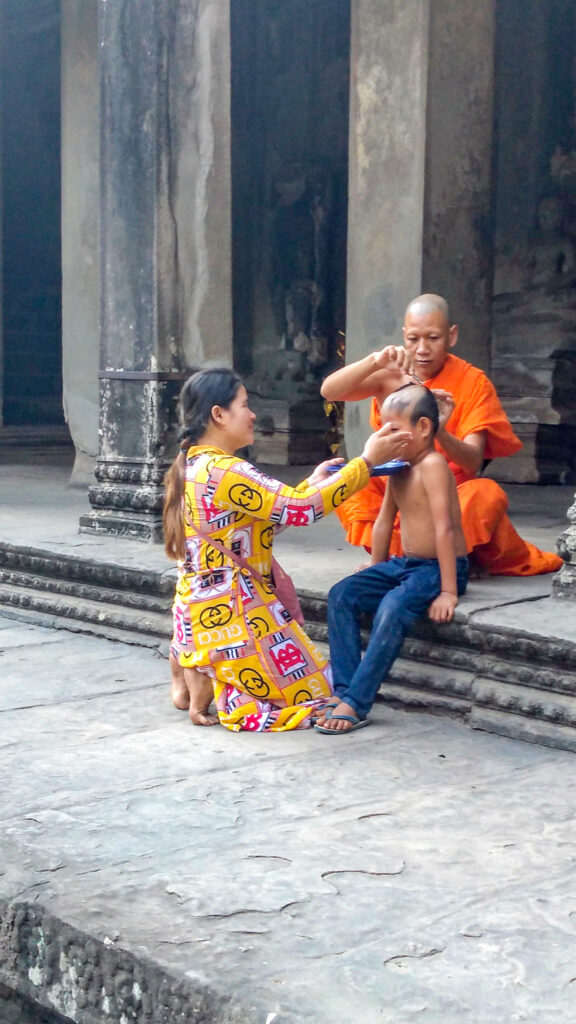
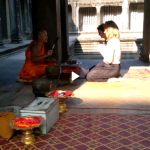
Prasat Kravan
A relatively small 10th-century temple consisting of five red brick towers. Bas relief depictions of Vishnu and Lakshmi are sculpted into the brickwork inside two of them. This is the only example of brick Bas reliefs in the Angkor area.
All five towers are assembled on a common raised base. The towers were restored from 1962 to 1966, the new bricks added are marked with a “CA” (meaning “Conservation Angkor”).

Srah Srang
A 700m by 350m picturesque baray (reservoir) located opposite Banteay Kdei. Still partially filled with water. It has an ornate landing-stage, the steps of which are flanked by two lion guards. Also, naga guardian statues carved into the balustrades.

Banteay Kdei
Meaning “a Citadel of Chambers”, it is a Buddhist monastic complex which has been occupied by monks at various intervals over the centuries right up until the 1960s.
Built on the site of an earlier temple, it is a tightly packed architectural muddle. Currently undergoing renovation. The complex is in poor condition and is dilapidated due to substandard construction and inferior quality sandstone used in its building.

Ta Prohm
Founded as a Mahayana Buddhist monastery and university in the late 12th and early 13th centuries. After the fall of the Khmer Empire in the 15th century, the temple was abandoned and neglected for centuries. It is in much the same condition in which it was found. As it is considered one of the best temples merged with the jungle.

Trees growing out of the ruins, wrapping themselves around the stonework, they create some elaborate and fascinating viewing. The trees growing out of the ruins are perhaps the most distinctive feature of Ta Prohm. A sprawling monastic complex, only partially cleared of jungle overgrowth, it offers some of the best “tree temple” photographs.

This is the temple referred to as the “Tomb Raider temple”. Its location was used in the Tomb Raider film of 2001, making it one of Angkor’s most popular temples.

Pre Rup
With a steep set of steps to climb in the heat, it was hard going to get to the top. Certainly worth the climb. To the rear, there are a set of wooden steps that are far easier than the stone ones at the front. An artistic temple mountain, containing some well-preserved carvings and details. The climb to the top provides excellent views across the surrounding countryside.

East Mebon
A three tier temple mountain, topped with five towers, most having well-preserved carvings. Two-meter-high free-standing stone elephants are at the corners of the first and second tiers.
The temple stands on what was an artificial island at the centre of the now dry East Baray reservoir. Four landing stages at the base give a reminder that the temple was once reached by boat.
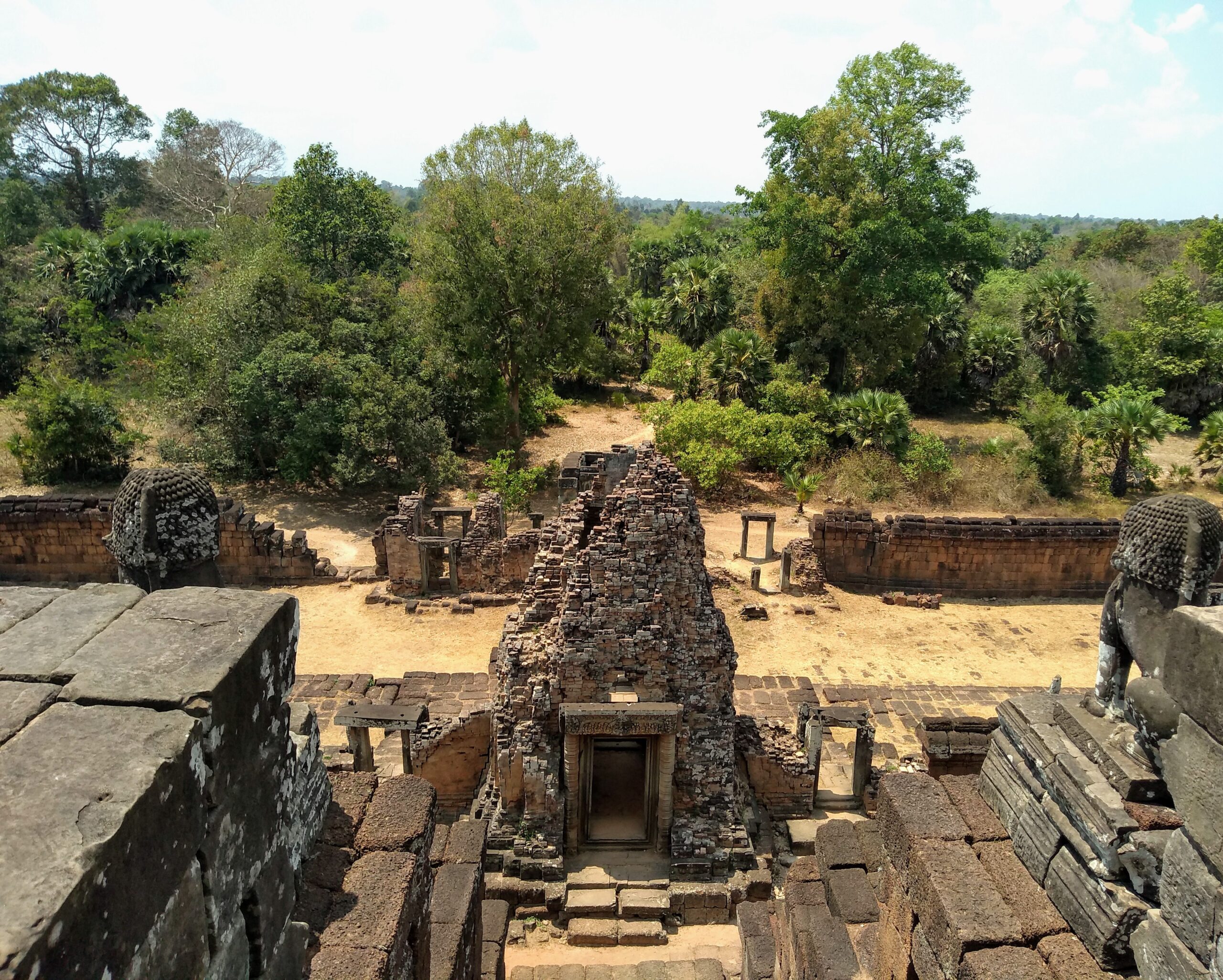
Neak Pean
An island temple located in the middle of Jayatataka Baray, the last baray constructed by a Khmer king in the Angkor area. Accessible across a boardwalk bridge, it was originally designed for medical purposes. Being believed that going into the four pools would balance the elements of the bather, thus curing disease.


Based on the ancient Hindu belief of balance, with four connected pools representing Water, Earth, Fire, and Wind. Each pool is connected to the main tank, by a stone channel. Presided over by one of Four Great Animals, Elephant, Bull, Horse, and Lion.

Preah Khan
Left largely unrestored, with numerous trees and other vegetation growing among the ruins. Preah Khan is another large monastic complex, full of passages and carvings. Originally a Buddhist monastery and school, it was the centre of a substantial organisation, with almost 100,000 officials and servants, including 1000 dancers and 1000 teachers.
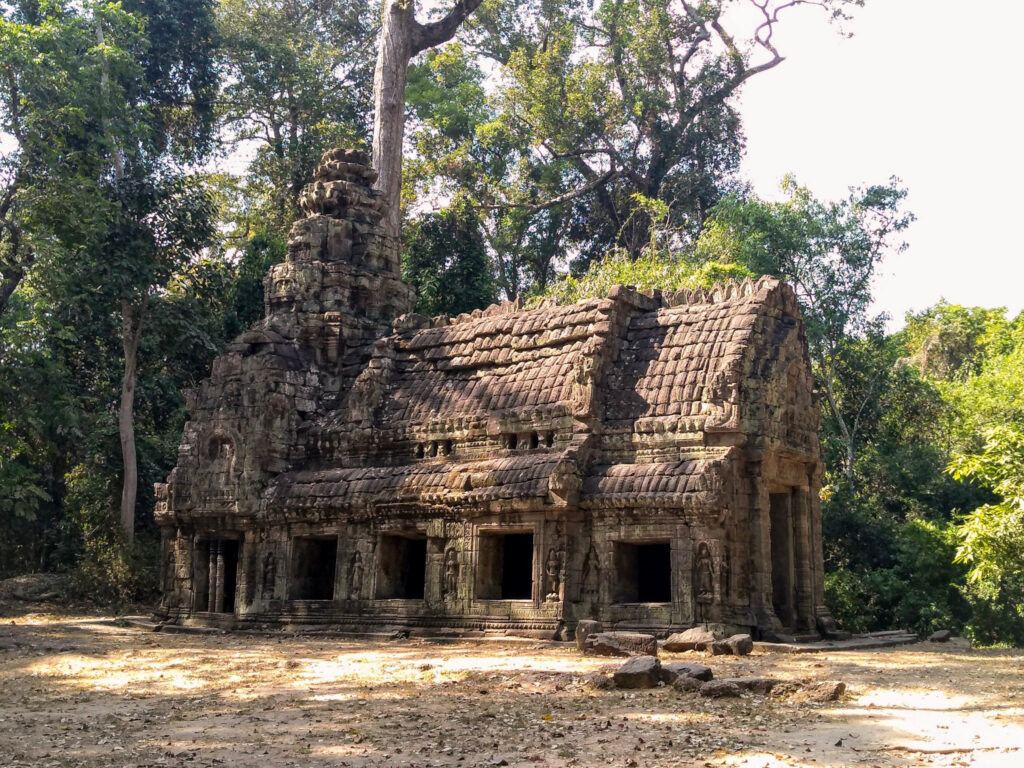
Very little restoration of the complex has been carried out, as little is known about the original complex. Further restoration would involve too much guesswork. So it is only maintained to avoid unintentionally falsifying history.

City of Angkor Thom
The last and most enduring capital city of the Khmer Empire. A fortified city that was home to priests, officials of the palace, and military personnel, as well as administration buildings for the kingdom.
Covering an area of 9 km², the city of Angkor Thom, literally translated to “Great City”, is constructed in the form of a square. Each side has a 3km long, 8m high wall. An earth embankment supports the inside of the wall and serves as a road around the city. At each corner of the wall, on the embankment that almost reaches the top of the wall, are small Buddhist temples known as Prasat Chrung.
A moat surrounds the outer wall, long causeways crossing the moat to entry towers midway along each wall. The east wall, unlike the others, has two entrances. The additional entry is known as the “Gate of Victory” is 500m to the north of the East gate. A causeway from this gate leads directly to the Terrace of the Elephants and the Terrace of the Leper King.
The entry tower causeways are flanked by a row of 54 stone figures on each side. Demons to the right and gods to the left. These mythical beings guard the city. The demons have a grimacing expression and wear a military headdress, the gods look serene with their almond shaped eyes and wear a conical headdress. Each sandstone entry tower is 23m high and is crowned with four heads.

Bayon
At the exact centre of the City of Angkor Thom is the state temple, known as the Bayon. The last state temple to be built at Angkor. Originally named Jayagiri (Victory Mountain), under the French occupation it was later named Banyan Temple, which through mispronunciation became Bayon.

The basic plan of the temple is simple. Comprising three levels, the first and second levels are square galleries featuring bas-reliefs. A circular Central Sanctuary dominates the third level. Despite this seemingly simple plan, the arrangement of the Bayon is complex.
A maze of galleries, passages, and steps, connected in a way that makes the levels practically indistinguishable. Creating dim lighting, narrow walkways, and low ceilings.
The temple itself has no wall or moats protecting it, this protection is offered by the city defences. The Bayon’s most distinctive feature is the famous “face towers”, the 216 smiling stone faces on the towers of the upper terrace.
Terrace of the Elephants
The Terrace of the Elephants is located in the Royal Square in the city of Angkor Thom. As part of Phimeanakas, which served as the King’s temple. The terrace was used by the king as a platform to view his victorious returning army. Standing 2.5m high and over 300m long, the terrace would have been adorned with impressive structures.
These are no longer in existence and all that remains is the platform on which the structures once stood. It derives its name from the carvings of elephants on its eastern face and the famous parade of elephants complete with their Khmer mahouts at either end.

Terrace of the Leper King
Still within the confines of the city of Angkor Thom, to the north of the Terrace of the Elephants is the Terrace of the Leper King. Here, sitting in Javanese fashion is a stone statue of the monarch, absolutely naked. The modesty of the monarch is generally covered with a monk’s saffron robe.
This is not the original Leper King statue, that is in the courtyard of the National Museum in Phnom Penh. Mystery and uncertainty surround the origins of the curious name of this terrace. Legend has it that Jayavarman VII was a leper and that is why he built so many hospitals throughout the empire.
Another theory suggests that the Leper King statue got its name because its discolouration and the moss growing on it make it reminiscent of a person with leprosy. Neither of these has any historical support whatsoever.
Having covered all of these temples. Walking miles in 37-degree temperature, climbed up and down numerous steps we were absolutely exhausted. We had planned to watch the sunset from the mountain but, fading fast. We decided it was probably best to leave that.
It is possible to see a lot of temples and sights in one day. It is hard going and even harder in the heat of the day. It really just depends on how into temples you are and how many you would like to see. We were more than content to put in one day’s hard sightseeing, seeing the major temples, plus a bit more.
Consider carefully what you want from your visit here. Real temple buffs could spend a month here and only scratch the surface of fulfilling their lust for knowledge of the Khmer Empire. Some may wish to see what we saw but do it at a more leisurely pace. Prepare yourself an itinerary based on your length of stay and your level of interest. Whatever you choose, you will be amazed and in complete awe at what you see.











